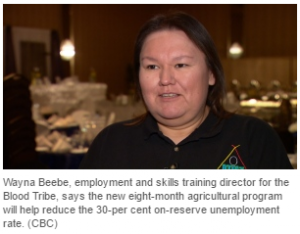For my research topic, I have chosen to look at how First Nations groups might use technology to preserve their cultures and change they way they are perceived and portrayed in today’s society. I focused my search for module 2 keeping this topic in mind.
- The first source I found is a Masters Paper from Athabasca University. It is titled The Perpetuation of Native Stereotypes in Film and is written by Kimberley Kiyawasew. In this paper, Kiyawasew talks about some of the stereotypes of Native Peoples that are portrayed in the film industry. She then goes on to talk about First Nations Filmmakers and how they are changing the storylines and making films that “reflect a truer representation of Native people” (Kiyaywasew, 2014, p.1). These films are challenging the stereotypes that have been previously established by the media and film industry and are a way that First Nations groups are representing themselves to the world in an authentic way.
- My second source doesn’t necessarily connect with my research topic but thought it was worth sharing. My friend Carolyn Roberts has created a website, complete with lesson plans around Indigenous education. On this site, she include online and print resources to use in the classroom. She is from the Squamish Nation Indian Band but her ancestors came from the N’Quatqua Band in D’Arcy BC. Because of her background, I trust this to be an authentic source of information and some might find it useful to their studies. http://www.carolynroberts.net/about-me
- The third source that I looked at was called Reconciliation Canada. “Reconciliation Canada, an Indigenous-led organization, began in September 2012 with a bold vision to promote reconciliation by engaging Canadians in dialogue that revitalizes the relationships between Indigenous peoples and all Canadians in order to build vibrant, resilient and sustainable communities. A vision based on a dream held by Chief Dr. Robert Joseph, Reconciliation Canada’s Ambassador, to witness tens of thousands of people of every culture and faith walking together for a shared tomorrow.” On this site, you can learn about programs and initiatives surrounding Reconciliation, as well as many online videos and resources on this topic. As this is an Indigenous-led organization, I believe it to be an authentic source of information and shows Indigenous cultures using technology to represent themselves.
- The fourth source I looked at was Animikii. They are an Indigenous-Owned technology company based in BC on Coast Salish Territory; “Our technology enables our clients to maximize their social and cultural impact by making effective use of web-based technology. By connecting people with technology we believe that this will build a stronger identity for Indigenous people.” This is a great resource as it shows how technology is being used to represent and connect Indigenous cultures. It also has links to websites that they have created for various clients, providing access to authentic sources of information.
- The fifth source that I looked at was the First Nations Technology Council. “The First Nations Technology Council has been mandated by the First Nations Summit, BC Assembly of First Nations and the Union of BC Indian Chiefs to address the technology related needs of BC’s First Nations communities.” One of the goals of the First Nations Technology Council is the “revitalization and preservation of language and culture,” which fits in with my research topic.



